 They say you drive for show and putt for dough, so that would make the putter many player’s “money club,” right? This week, we’re going to look at famous money clubs.
They say you drive for show and putt for dough, so that would make the putter many player’s “money club,” right? This week, we’re going to look at famous money clubs.
Putters, as we all know, come in many shapes and sizes. Putters can be shaped like Futura Phantoms or the Ping Docs and look perfectly normal sitting next to a Ping Answer or a Bullseye. Putters may be the most personal instrument in a player’s bag, with everything from the lie angle, face angle, grip, shaft length, and weight coming into play and combining to give that magical sensation – feel – to the player.
When the tournament is on the line, what famous putters stroked some famous putts? Find out in this week’s edition of Trap Five.
Number Five: PING
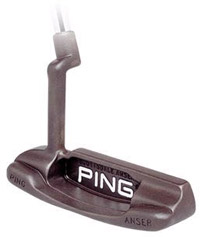 Karsten Solheim was a General Electric engineer and a golf nut. His engineering background and his passion for golf combined in his Phoenix garage where he began working on his putting game not by practicing his stroke, but by creating a new putter. Though he made several playable prototypes, only one made it out of his garage in the end: the original PING putter, so named because of the sound the putter made when it struck a golf ball.
Karsten Solheim was a General Electric engineer and a golf nut. His engineering background and his passion for golf combined in his Phoenix garage where he began working on his putting game not by practicing his stroke, but by creating a new putter. Though he made several playable prototypes, only one made it out of his garage in the end: the original PING putter, so named because of the sound the putter made when it struck a golf ball.
Solheim’s Anser putter – a revision of the original PING – was used by Julius Boros to win the Phoenix Open in 1967, and sparked a trend that’s continued to this day: heel-toe weighting in putters (and perimeter weighting in all other clubs). Solheim’s PING putters spread the weight towards the heel and toe to minimize distance loss on off-center hits, effectively enlarging the sweet spot. Almost every putter today uses heel-toe weighting.
Number Four: Wilson 8802
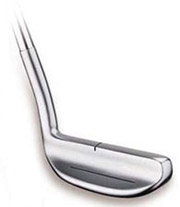 Arnold Palmer made it famous, but one of the best putters of all time – Ben Crenshaw – elevated the Wilson 8802 to a special place in golf’s history. Nicknamed “Little Ben,” Crenshaw’s 8802 was with him through thick and thin, but a replica was used to win the improbable one in 1995 (see comments below). Said Crenshaw’s dad of Ben’s original 8802, “It was just a putter in Harvey Penick’s shop. Ben felt it and waggled it around for a while. ‘Dad, I’d like to have it,’ he said, so I bought it for him. That club’s been the best provider in the family.” The putter cost Crenshaw’s dad $20.
Arnold Palmer made it famous, but one of the best putters of all time – Ben Crenshaw – elevated the Wilson 8802 to a special place in golf’s history. Nicknamed “Little Ben,” Crenshaw’s 8802 was with him through thick and thin, but a replica was used to win the improbable one in 1995 (see comments below). Said Crenshaw’s dad of Ben’s original 8802, “It was just a putter in Harvey Penick’s shop. Ben felt it and waggled it around for a while. ‘Dad, I’d like to have it,’ he said, so I bought it for him. That club’s been the best provider in the family.” The putter cost Crenshaw’s dad $20.
The 8802 is a simple putter with no heel-toe weighting to speak of and a very clean, simple look. Its design may have been inspired by Calamity Jane (see below), and it won nearly as many majors. Arnold Palmer used the 8802 (and a small revision, the 8813) to win several of his majors, and Phil Mickelson has always seemed to putt best with his remake (currently made by his sponsor Callaway – i.e. Odyssey) of the venerable 8802.
Number Three: Calamity Jane
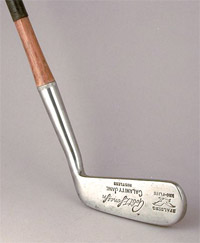 Arguably the U.S.’ most famous golfer (Jack Nicklaus and Tiger Woods being the only real competition), Bobby Jones mastered golf long before The Masters came to be. His putter, nicknamed Calamity Jane, was a simple offset blade putter forged by Condie and sold by William Winton. The putter was almost 20 years old and already had its famous nickname when it was given to Jones in 1920. Jones replaced the original in 1926 with a duplicate known as Calamity Jane II (and mmade by Spalding). Jones won the last 10 of his major championships with Calamity Jane II and later gave the putter to the USGA Museum. The original remains on display at Augusta National Golf Club.
Arguably the U.S.’ most famous golfer (Jack Nicklaus and Tiger Woods being the only real competition), Bobby Jones mastered golf long before The Masters came to be. His putter, nicknamed Calamity Jane, was a simple offset blade putter forged by Condie and sold by William Winton. The putter was almost 20 years old and already had its famous nickname when it was given to Jones in 1920. Jones replaced the original in 1926 with a duplicate known as Calamity Jane II (and mmade by Spalding). Jones won the last 10 of his major championships with Calamity Jane II and later gave the putter to the USGA Museum. The original remains on display at Augusta National Golf Club.
After winning the Grand Slam in 1930 and retiring, Jones began consulting for Spalding – at that time a clubmaking giant. From 1932 to 1973, Spalding produced a line of clubs under Bobby Jones’ name. Dozens of Calamity Jane models in both hickory and steel shafts were made in those 40+ years, but none contained the magic of the original and none won a major of their own.
Number Two: Schenectady
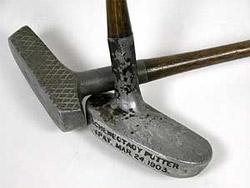 Walter Travis, an American golfer in the early 1900s, was deadly with his putter. So deadly in fact that he mastered the tricky British Amateur greens and became the first American to win the British Amateur in 1904. His putter? The “Schenectady,” named by inventor Arthur F. Knight after his hometown in upstate New York.
Walter Travis, an American golfer in the early 1900s, was deadly with his putter. So deadly in fact that he mastered the tricky British Amateur greens and became the first American to win the British Amateur in 1904. His putter? The “Schenectady,” named by inventor Arthur F. Knight after his hometown in upstate New York.
Having sinned against all of Britain by helping Travis hole putts from everywhere in 1904, the Royal & Ancient promptly banned the putter from all competitions – a ban which lasted until 1952. Though the official reason given was that the putter was considered a “mallet-headed type” similar to a center-shafted croquet mallet, the real reason was quite evident to all who witnessed or heard of Travis’ performance that year.
Travis’ actual Schenectady putter may have been lost to the sands (or greens) of time: its exact whereabouts are unknown at this time.
Number One: Odyssey Dual Force Rossie 2
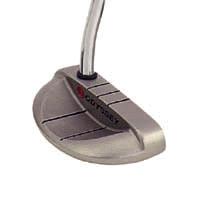 Nick Faldo seems a rather unassuming fellow, and hardly one associated with putting. Though he “putted for dough” quite frequently, winning six majors, it was his superb accuracy and calm under pressure that set him apart.
Nick Faldo seems a rather unassuming fellow, and hardly one associated with putting. Though he “putted for dough” quite frequently, winning six majors, it was his superb accuracy and calm under pressure that set him apart.
One of Faldo’s six majors occurred in the 1996 Masters, the year of Greg Norman’s historic collapse. Faldo’s putter that week was the unassuming Odyssey Dual Force Rossie 2, a mallet-shaped putter with an S-bend shaft. Both of those features were (and remain) fairly common, but the Rossie was the first putter with an insert. We see inserts in putters today, including just about every Odyssey putter (including the White Hot 2-Balls).
The insert and Faldo’s win caused such a stir that golf shops couldn’t keep up with orders for months to come. Players at the Senior PGA Championship a week after the Masters in 1996 had to buy their own Rossies from the pro shop because the Odyssey rep ran out of putters. Odyssey was later purchased by Callaway for a tidy $130M.
Just Missing the Cut
The Bullseye, used by Corey Pavin to win the 1995 U.S. Open and often by Tom Kite (as well as many other players) is a classic putter. What’s best is that you can still find this putter today.
The George Low Sportsman Wizard 600 was used by Jack Nicklaus for many – but not all – of his majors. Jack was always known for his putting, but his success didn’t sell a ton of Wizard 600s.
The Odyssey Two-Ball has been used by every serious golfer – at least on the practice green when borrowed from a friend – since it was introduced a few years ago. Its design has been copied by many, but the original and subsequent revisions remain the most popular.
Next Week
I’m not sure what we’ll count down next week, but feel free to leave suggestions in the comments (below).

Karsten first made putters in his garage in Redwood City, California.
I’ve just read your article on the five most five most putters and you mention that the Wilson 8802 putter was used by Crenshaw for his 1995 Masters victory. I would respectfully like to correct you; the putter he used for that win was a Cleveland putter which he designed for them. This is from the horses mouth Carl Jackson, Crenshaw’s constant caddie at the Masters.
I have just acquired a Schenectady Putter with markings as shown in your photograph with the possible exception of the “sweet spot” grove which is just in front of the hosel on the top of my putter head. The sole of the head is stamped “No.976267 SOLE LICENSEES HARRY C. LEE & Co NY”. The sole also has a stamping of an acorn on a branch with the word “UPRIGHT”. Any info you can give me will be appreciated.
C Pavin won the Open with a Cleveland Designed By putter, not a Bullseye..also, the putter you hve pictured as an 8802 is an 8813…8802s had no sightlines…A Palmer won the 1960 US Open with a doctered up Macgregor IMG Ironmaster…8802s weren’t even made by Wilson until 1964…Palmer got Wilson to come up with the “Designed By A Palmer” putter in 1962, 1963 which was a copy of the Macrgegor IMG…then Palmer left Wilson after 1963 and the 8802 replaced the Des. By AP putter in 1964…Palmer never won a Major after 1964…as far as your statement “the Rossie was the first putter with and insert”, many, many , many putters were made with inserts before the Rossie. including the George Low line of mallet putters in the early 1960s…
I have a Spalding Line Rite putter with a steel shaft covered with some sort of plastic to simulate hickory. Does anyone have any idea of the age or history of this putter?
Ben Crenshaw also won the 1984 Masters with a Cleveland blade putter, not his trusty 8802 “Little Ben.” The Cleveland blade belonged to his manager. Ben promptly returned the putter to his friend after his victory in 1984 and went back to his 8802. The Cleveland blade he used to win in 1995 was a different putter (same model though) than the one he used in 1984. Since he won his two majors with a Cleveland putter instead of the 8802, it makes you wonder why he didn’t stick with the Cleveland.
I have 2 ping putters that appear unique. One has “Friends of Tom Fazio Invitational” & an engraving of one of his golf course on the sole of a Ping 5 BZ A-Blade putter. The other has a “green globe with swinging golfer” on the sole as well as being numbered (121/150). The shaft label on this
Ping 5BZ B60 reads World Championship of Golf Inaugural Tournament 12-31-95. I’d like to know more about these 2 putters and if they have more than typical value.
I have the Ping anser, best putter ever
Does anybody know what year the Wilson gooseneck was made.
Re your review of the Wilson 8802. The putter pictured is not an 8802, although it might be a clone. The real 8802 (which does not say ‘Original’ on the sole) does not have a top sight line or scoring along the back sole.
I have an 50’s Wizard 600, it’s still a great putter today!
8802 style is probably best overall putter ever. Look at all the copies everyone produces of it. Cobra, Cleveland , etc. Macgregor IMG, Spalding Blue Chip, Low putters are all similar to the 8802 model.
Don’t forget the Otey Crisman line of mallets, most with hickory shafts.
Do you knowanything about the Crisman S100. My research reveals nothing. Thanks
I have a ‘Young Otey’ putter that I would sell. Wooden shafted, mallot head, with five lead inserts in the bottom. Registration #73H.I have had this all my golfing life, approx. 70 years
Please advise if you are interested.
I have the original Wilson 8802 putter. The original has the words ‘The Wilson 8802’ stamped on the sole and nothing else. I believe this putter was made before 1963 as I was born that year and I’m positivethat it is older than me. It has the original leather grip still and ‘Head’ shaft. I’d love to know what it’s worth, any ideas? please e mail me if you do
i have a acushnet 7-110 putter with a leather padal type grip,
the shaft is bent foreword. i am guessing it was made in 1930s
or 1920s. can anyone help me?
That isn’t an 8802 pictured but rather a Wilson 8813 which is identical to 8802 but with sight lines added. To this day, I cannot putt without a sight line and I still don’t know how they did with the 8802.
Im a golf pro in Buenos Aires, Argentina…and I own two of those putters. Since you sent your comment a few months ago, I.d like to know if you had any answer, mainly on the price of the putter. Gracias in advance!!!
In regards to the putter Ben Crenshaw used in the 1995 Masters. It was a “Designed by: Ben Crenshaw” Cleveland putter. Trust me, I have coresponded with Ben on many occasions and he let me know what the putter was that he used that week.
Have a great day.
I’ve had a Wilson 8802 putter for more years than I can remember-at least 40. Only the words “The Wilson 8802” are stamped on the putter sole and it has a sightline, unlike the putter mentioned by r brown in his note above. Mine has a hard rubber Grip Rite grip, not the original I would think. I’m also interested in the value of this putter-anyone have any ideas?
I have an old Palmer putter I would like to know more about. Brass head, has the name Palmer in large cursive letters and “rb821” on the sole, no sightline, fluted shaft. No other markings on head. Grip has patent #. I’ve tried several other putters and always go back to this one, just feels the best. Any info on age and value of putter is appreciated.
I have an original 8802 that was either a proto or revised. The face has dimples machined into it – makes for a nice soft feel.
I also have an IMG style putter probably monel. It is engraved on the bottom “1981 World Golf Hall of Fame” and Custom. It has a metal “Smith-style” ferule. Any one have any idea where it came from…
FYI Lee Trevino and Ralph Guldal were inducted. (Lee has autographed the face – last year in Savannah)
I have a rh George Low Wizard 200 with a fluted shaft and insert. I also have a Wilson 8802 rh putter. Can you give me an idea of their worth and where to sell them?
just come across a schenectady putter in very good shape. harry c lee no.976267. pat. march 24 1903. any info would be appreciated
anyone aware of the Muirfield (MacGregor) putter? To me, it is quite like the original Wilson 8813 (no sight lines). Apparently, Nicklaus used this at one time, since his name is on the bottom of the head.
I don’t understand all the furor over the Scotty Cameron putters. I guess the fact that Tiger Woods plays them makes all the difference. They basically in many ways are updated versions of many of the original Ping putters. I don’t find them to be so wonderful. In fact, putters made by Tad Moore and Bettinardi in my opinion are better balanced, aligned and have better feel. Just one ,am’s opinion. God bless Scotty, everything he puts out seems to turn to gold !!!
I’m going to guess you didn’t quite mean furor there…
Scotty Cameron makes a lot of putters. They’re all of a high quality.
Scotty putters are as well balanced as any other putters, and putters vary in their balance within lines. Some are face balanced, others have “toe hang” as Scotty calls it, and so on. Every putter line worth its salt has several putters that balance differently.
Besides, leveling the old “updated copies of Ansers” shows a certain amount of ignorance. The Detour isn’t a copy of anything. The Futura before it wasn’t. Find some new material, eh?
Any knowledge of a Otey Silver Touch (looks like a Bullseye) with wooden shaft? Worth anything?
I have the Jack Nicklaus Muirfield putter with the fluted shaft and original leather grip. Unfortunetly the shaft is bent and I have been looking everywhere to find this shaft. Does anyone know where to find one?
I have this putter that I just picked up at a garage sale!!! I can’t find any history. Do you know what it’s worth?? Thanks, Terry
I have a Faldo hotblade putter but can not find out if it is of value or how much it may be.
I have a Golden Ram/Tom Watson forged blade similar to the 8802. Used it for a few years. Also have Pings, an Anser, a Zing and my first Ping, a B61. Of all of them the Ping Anser is probably the favorite.
I have a George Low 600 by Macgregor Jack Nicklaus
two red lines on top any idea of worth.. willing to sell at reasonable offer
😀 I have an old original leather grip Acushnet Bullseye putter stamped designed by John Rueter model OS 4S with dual sight lines on top in excelent condition, looking for an idea of it’s age and value. Switch between this putter and my Odyssey putter. Love the feel of the brass head and depending on the speed of the greens I’m playing on will use this over the Odyssey at times.
I have seen this putter on the UK hotblade website, where they mention they have one in the archives.
http://www.hotblade.co.uk then select history tab.
I also have one, so would be interested in anyone with an idea of value as currently looking to sell.
Would be inyerested in purchasing an original 8802 or Palmer designed by. Any for sale in decent shape at a fair price ?? Please e-mail me at mike3847[at]aol[dot]com
Anyone looking to sell an old 8802 or Palmer designed by ?? Original condition, good shape at a reasonable price. Please respond to my e-mail. Thank you.
I have my late father’s “Wilson Designed by Arnold Palmer” putter which I saw in a Golf Digest Magazine 15 to 20 years ago which said it was valued at $1,250.00. I’ll never sell it because of its greater sedimental value, but am curious as to its value today.
I also have my mother’s “Northwestern Nancy Lopez 803” putter, and she has a “Mickey Wright’ puttter, one of which, if memory serves me was also featured in the same article,
I have inherited 2 old putters, and would appreciate any imformation as to there current value… They are as follows…
A Original Wizard 600 Sportsman, made in Melrose Park ILL
(excellent condition) always kept covered …
& A very early, PING KUSHIN.
US PAT NO. 5,042.405 & 166,734 PING GOLF CLUB BOX 1345 SCOTTSDALE, ARIZ OTHER PAT, PEND
It has the number 16 stamped in the sole
(very good condition) kept covered …
I have a similar Cushin stamped 17 34. The 34 is the length. I suspect the 17 (16 on yours) is head weight in oz, but cannot confirm. My best guess is these were prototypes produced by Karsten. Mine puts like a dream…
“I have a similar Cushin stamped 17 34. The 34 is the length. I suspect the 17 (16 on yours) is head weight in oz, but cannot confirm. My best guess is these were prototypes produced by Karsten. Mine puts like a dream…”
Many of the early Pings have a number either in the cavity or on the sole that show which particular mold was used to cast the head. If the number 17 was ounces, then that putter head would weigh over a pound
I have an Acushnet bulls eye putter that I have had since 68. John Reuter Jr LB U 4 6 Does anybody have any informationon this ?
I suspect that the LB is for light blade, the U for upright and the 4 0r 6 for length. I have a couple pre Acushnet that I recently acquired. Both shafts were connected with silver solder. I took the first apart to replace the plastic ferule over the grip bottom and replaced it using the silver solder. The second’s shaft was rusted beyond restoration and had to be replaced. BTW the first is heavy, no marks beyond the designed by and pull’s eye hand stamped. The grip is very thin and obviously hand assembled.
I HAVE A OTEY CRISMAN HAND CRAFTED PUTTER IT IS STAMPED ” OLD GOOSIE ” AND OTEY CRISMAN ON PUTTER HEAD I WOULD LIKE TO KNOW ITS WORTH AND THE YEAR IT WAS MADE IT WOULD MAKE A NICE PEICE IN SOMEONES COLLECTION
My Arnold Palmer putter [still in use with original leather grip] was a birthday present from my mother in 1966.
At Muirfield, at The Open, that same year, I bought what I consider the best golf book ever written – Arnold Palmers “My Game and Yours”.
Arnold signed it for me after I [literally] bumped into his caddie while walking out of the merchandise tent!
I apologised to him and then, rather flustered [as I saw who was with him], told Arnold what I had just bought. Polite as always he offered to sign it.
What a gentleman.
I have no plans to sell either, but would be interested to know what value they should be insured for. This information would be appreciated. Thank you.
have a harry d lee & co club ray model medium 9 ozs 15 dps the vew “milis” would like to know more about it .
Does anyone know anything about Jimmy Flowers putters?
I put with a Wilson Staff JP II sand wedge, works for me!
I have a spalding cash-in putter. It gives me excellent feel back and is my favourite club. What I am not quite sure about is its exact sweet spot since there is no mark to indicate this. I have however identified where I believe it to be based on performance. Anyone with simillar issue?
Actually most BRASS Putters are simply Stainless Steel covered with a Brass Finish.
I just brought my dad’s old Cash in back to the golf course, seemingly out of desperation as my Ping Anser was not performing of late. A totally different feel, but immediate improvement. Still adapting to the straight on alignment (vs. offset). The sweet spot issue is of some concern, but the way I’ve been stroking the ball lately….it’s the indian, not the arrow. Also adapting Utley’s square to the arc move to the ball vs. Pelz’s square to the target move. A toe balance putter like the Cash In works best with this type of putter swing.
I have collected classic golf clubs (primarily MacGregor woods)for 45 years now and in the process acquired numerous vintage putters. In fact I have a collection of all the putters mentioned in this article except for the George Low Sportsman even though I do have a George Low putter with just his name on the bottom, a golden insert and a tag on the shaft that simple calls it a George Low Special. I’m glad to see that there is still an active interest in classic golf clubs. I’ve only sold one golf club in all that time and that was an M-75 MacGregor driver to a young pro about 35 years ago but if you are looking for something in particular I might part with some of my clubs now that I’m retired.
have putter that was in old canvas golf bag at a yard sale.bronze,sand casted,only words on putter are Extended flange Pat pend CIFI in bottom of putter.have played with it half a dozen times and when you hit the golf ball on the sweet spot it makes a distinctive PING sound.It has adouble offset steel shaft first bend about 21/2 inches from bottom second bend about 61/2 to 7 inches from bottom of sole putter.From face of putter the flange goes back aprox 21/4 inches . can anyone help me identify who made it ? Could it possibly be a early prototype Ping
My dad Jimmy Flowers(Sr.) got a patent on a putter head (555) in 1938. Wilson was going to make the putters & pay him royalties but WWII ended that. In the late 40s he started making them himself just for friends etc then met a traveling salesman named “Wild” Bill Jellifee in the early 50s he traveled all over the US & sales took off. I am the one who made over half of these putters ever made. about 15Kor so. I am 76 yrs & still make one every now & then for kids & grand kids. Business went down due to salesman being restricted to Rocky Mnt area & foundrys in our area closing & lack skilled help. I went to work as a machinist for Goodyear chem in Beaumont Tx & later with Saudi Aramco retired in 1993 live in Port Neches Tx.
THERE IS NO VALID REASON TO BRASS PLATE A STAINLESS STEEL PUTTER HEAD. IF IT LOOKS LIKE BRASS IT IS BRASS! BRASS IS CHEAPER AND EASIER TO WORK WITH AND FINISH THAN STAINLESS.
I do think that most brass putters are just heavily coated over lead or something else heavy and cheap (not stainless). On heavily used Bullseyes one can see the lead showing through on particularly deep nicks for example; but most people, originally myself included, think the Bullseye solid brass. Other brass putters would be the same.
The comment above about Crenshaw’s 1984 Masters winner being a Cleveland is interesting. There is a photo by Phil Sheldon during the second round showing Ben kneeling and lining up a putt and the bottom of his club is visible. It reads “The Wilson” in red on the top line and “8802” below.